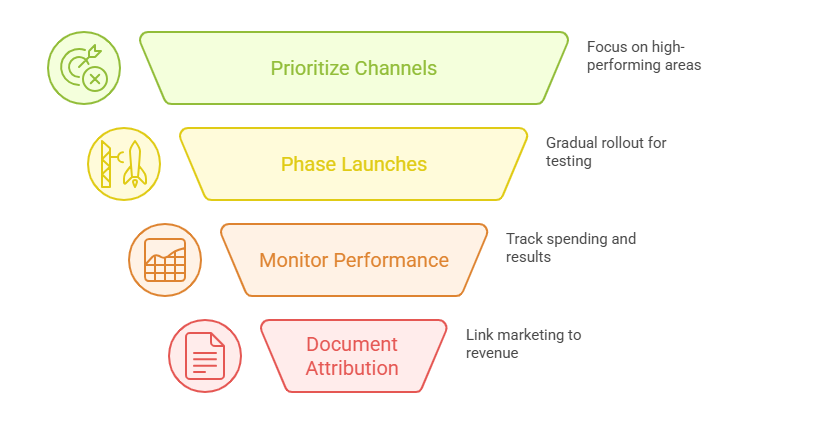Growing your marketing efforts often requires significant upfront investment, but traditional financing options may not align with the variable nature of advertising returns. Using revenue-based financing for marketing expansion offers a flexible alternative that matches repayment terms to your actual campaign performance. This funding approach allows businesses to scale their advertising budgets while maintaining cash flow stability during slower periods.
Revenue-based financing provides capital in exchange for a percentage of future revenues, creating a payment structure that naturally adjusts to your business's success. When marketing campaigns generate strong returns, you might pay more toward the advance. During quieter periods, your repayment obligations typically decrease proportionally.
Setting Up Your Marketing Expansion Strategy
Setting up your marketing expansion strategy with revenue-based financing requires careful planning and realistic goal setting. This structured approach helps ensure your campaign funding aligns with business objectives and repayment capabilities.
- Assess your current marketing performance: Review existing campaign metrics, conversion rates, and customer acquisition costs to establish baseline performance indicators that will guide your expansion plans.
- Define expansion goals and budget requirements: Determine specific marketing channels you want to scale, target audience segments to reach, and the total funding amount needed for meaningful growth.
- Calculate revenue projections: Estimate potential revenue increases from expanded marketing efforts, considering seasonal fluctuations and market conditions that might affect campaign performance.
- Establish ROI tracking systems: Set up comprehensive analytics and tracking mechanisms to monitor campaign effectiveness and ensure you can demonstrate revenue growth to justify the financing investment.
Implementing Campaign Funding Through Revenue-Based Financing

Implementing campaign funding through revenue-based financing involves strategic allocation of resources across different marketing channels. This systematic approach helps maximize the impact of your expanded advertising budget.
- Prioritize high-performing channels: Focus initial funding on marketing channels that have demonstrated consistent returns, allowing you to build momentum before exploring new advertising opportunities.
- Phase your campaign launches: Roll out expanded marketing efforts gradually, testing performance at each stage to optimize spend allocation and identify the most effective strategies for your business.
- Monitor daily spending and performance: Track advertising expenditures and results closely during the initial expansion phase, adjusting budgets based on real-time performance data and revenue generation.
- Document revenue attribution: Maintain detailed records linking marketing activities to revenue increases, providing clear evidence of campaign effectiveness and supporting future financing applications.
Optimizing Ad Budget Scaling with Flexible Repayment
Optimizing ad budget scaling with flexible repayment structures allows businesses to adjust their marketing spend based on campaign performance and seasonal variations. This approach typically provides more breathing room during challenging periods.
- Align budget increases with revenue growth: Scale advertising spend proportionally with revenue increases, ensuring that expanded marketing efforts generate sufficient returns to cover repayment obligations comfortably.
- Build in seasonal adjustments: Account for predictable business cycles when planning campaign funding, allocating larger budgets during peak seasons and reducing spend during slower periods.
- Create performance thresholds: Establish specific ROI benchmarks that trigger budget increases or decreases, helping maintain profitability while maximizing growth opportunities through strategic spending.
- Reserve contingency funds: Set aside a portion of campaign funding for unexpected opportunities or to maintain minimum advertising presence during revenue downturns.
Benefits of Revenue-Based Marketing Financing
Revenue-based marketing financing offers several advantages over traditional funding methods, particularly for businesses with variable cash flows or seasonal revenue patterns.
- Flexible repayment structure: Payments typically adjust based on your business performance, providing relief during slower periods while allowing you to pay more when campaigns generate strong returns.
- No equity dilution: Unlike investment capital, revenue-based financing allows you to maintain full ownership of your business while accessing funds for marketing expansion.
- Faster approval process: Many revenue-based financing providers may approve applications more quickly than traditional lenders, helping you capitalize on time-sensitive marketing opportunities.
- Performance-aligned costs: The financing structure naturally aligns with marketing success, as repayments often correlate with the revenue your campaigns generate.
ROI Tracking and Repayment Alignment Strategies
ROI tracking and repayment alignment strategies help ensure that your marketing expansion efforts generate sufficient returns to justify the financing investment while maintaining healthy cash flow.

- Implement comprehensive attribution models: Use multi-touch attribution systems to accurately track how marketing channels contribute to revenue, providing clear data on campaign effectiveness and return on investment.
- Monitor customer lifetime value: Track long-term customer value generated through expanded marketing efforts, not just immediate sales, to better understand the true impact of your advertising investments.
- Regular performance reviews: Conduct monthly assessments of marketing ROI and repayment capacity, adjusting strategies as needed to maintain profitability and meet financing obligations.
- Maintain detailed financial records: Keep thorough documentation of marketing spend, revenue attribution, and repayment history to support future financing applications and demonstrate successful campaign management.
Using revenue-based financing for marketing expansion can provide the flexibility and capital needed to grow your advertising efforts without the constraints of fixed repayment schedules. This financing approach aligns your costs with performance, potentially making it easier to manage cash flow during the inevitable ups and downs of marketing campaigns.
The growing revenue-based financing market, which may reach significant scale in the coming years according to industry projections, suggests that more options and potentially better terms could become available for businesses seeking marketing expansion capital. By understanding how to structure campaigns, track ROI effectively, and align repayments with performance, you can position your business to take advantage of this flexible financing option.
Success with revenue-based financing for marketing expansion typically depends on careful planning, thorough performance monitoring, and realistic expectations about campaign returns. When implemented thoughtfully, this funding approach might help you scale your marketing efforts while maintaining the financial flexibility needed to adapt to changing market conditions.

.png)






